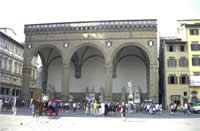Loggia of the Signoria
A rare example of late Gothic work, the Loggia of the Signoria, also called as the loggia of Orcagna, or Loggia dei Lanzi (with reference to the mercenary guards of the Grand Duke Cosimo I), was built by Benci da Cione and Simone Talenti (1376-1391) for the public assemblies of the Signoria.
The construction was actually owed to the same architects who were in charge of the construction of the Cathedral: Benci di Cione, Simone di Francesco Talenti and was built for the elections and proclamations of the Priors and the Gonfalonier as well as other ceremonies of the Signoria.

The spacious elegance of the building is typically late Gothic. The fine relief panels above the piers show allegorical figures of Virtues, executed between 1384 and 1389 on designs by Agnolo Gaddi.
The statues in the Loggia della Signoria
In 1788 the antique feminine statues and the two lions on the steps at the entrance which carne from the Villa Medici in Rome were placed here; beneath the first arch on the left is the Perseus, the bronze masterpiece of Benvenuto Cellini carried out between 1545 and 1554 and immediately destined for this spot. One should note the power of the modelling and the harmnony of the parts of great pictorial effect. Behind this group is the « Rape of Polyxena » a very fine nineteenth century sculpture by Pio Fedi realised in 1866. In the middle of the loggia is Menelaus supporting the body of Patroclus, an ancient sculpture from a Greek original given to the Grand Duke Cosimo I by Pope Pius V and brought to Florence in 1579.
Six statues or matrons dating to Roman times are set against the back wall. A Latin inscription on the right wall, dating to 1750, refers to the substitution of the Florentine calendar, with the beginning of the year on March 25th.